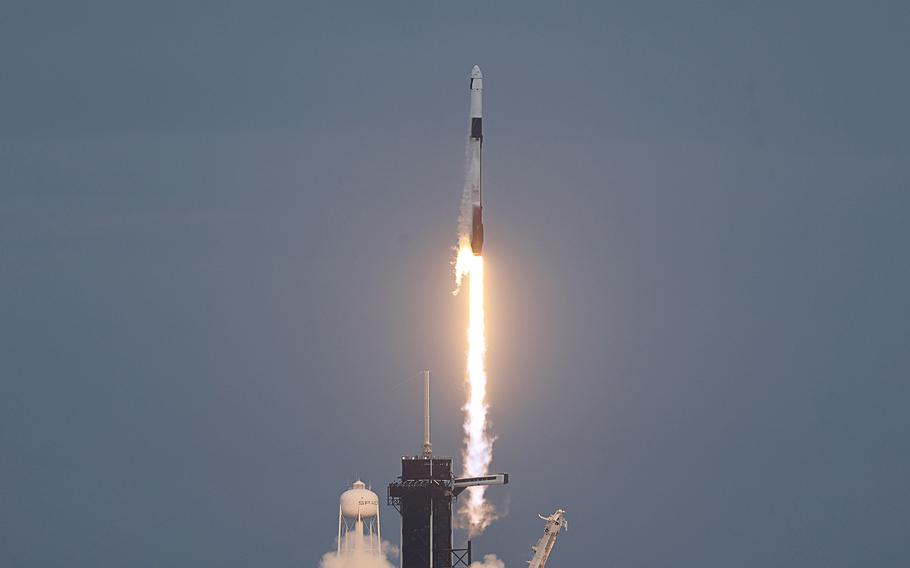
SpaceX and Axiom Space launch the Ax-3 mission on the Crew Dragon Freedom on Jan. 18, 2024, in Cape Canaveral, Florida. (Ricardo Ramirez Buxeda, Orlando Sentinel/TNS)
CAPE CANAVERAL, Fla. (Tribune News Service) — SpaceX carved its way through cloudy skies on the Space Coast, sending up a four-man crew on a private mission to the International Space Station.
The quartet rode on the Crew Dragon Freedom, making its third trip to space atop a Falcon 9 rocket that blasted off from Kennedy Space Center’s Launch Pad 39-A at 4:49 p.m. Eastern time on the Ax-3 mission for Houston-based Axiom Space. The first-stage booster made its fifth flight, coming back for a landing at Cape Canaveral Space Force Station’s Landing Zone 1, sending a sonic boom across parts of Central Florida.
“The four of us that are lucky enough to man the good ship Freedom at this point are humbled to be on the team. We are grateful to our teammates, and we are go for launch,” said mission commander and former NASA astronaut and Axiom chief astronaut Michael López-Alegría ahead of liftoff.
López-Alegría, who has both U.S. and Spanish citizenship, leads the all-European crew of Italian Air Force Col. Walter Villadei, acting as pilot, and mission specialists Alper Gezeravcı of Turkey and ESA project astronaut Marcus Wandt of Sweden.
“Walter, Albert and Marcus, congrats. Welcome to your first flight on Dragon,” said SpaceX crew operations and resource engineer Jake Vendl after liftoff. “Mike, on the other hand, welcome to the Dragon frequent flyer club. I imagine you’ll have enough miles to qualify for platinum status after this flight. Godspeed, Axiom Three. Cheers.”
López-Alegría, who flew on Axiom’s first commercial mission to the ISS in 2022, is making his sixth trip to space, one shy of matching the record for orbital launches. He flew four times during his NASA career aboard both the space shuttle and Russian Soyuz rockets. This trip will tack on to the 275 days he’s already spent in orbit.
“Dragon, this is the Falcon team, we want to congratulate you on a great ride to orbit,” said SpaceX chief engineer Bill Gerstenmaier. “I think you’re demonstrating the ultimate in reuse — a reused commander, a reused Dragon and a reused Falcon, or maybe flight experience is a better word. Enjoy space.”
Gezeravcı became Turkey’s first astronaut, and his arrival at the ISS will mark the 22nd country to be on the station. It’s also Wandt’s first trip to space, but Villadei actually took a suborbital flight to the cusp of space on a Virgin Galactic flight last year.
“I think it’s my duty to try to warn them about what it’s going to feel like especially physiologically, because I want them to be prepared for that,” said López-Alegría. “But as far as experience goes, I just want them to have it — to soak it up, let it go through their pores and feel what it’s like.”
Ax-3 is the first of two planned missions for the company in 2024 and one of up to six human spaceflight missions planned from the Space Coast. Five of those six could come from SpaceX, including next month’s crew rotation mission, Crew-8. The other company sending up a human spaceflight is United Launch Alliance, sending up Boeing’s long-delayed CST-100 Starliner atop an Atlas V rocket from Cape Canaveral for a short trip to the ISS.
To date, SpaceX has now flown 46 people among 12 flights of its fleet of four Dragon spacecraft since the first Demo-2 mission in 2020. Both crew and cargo Dragon spacecraft have logged more than 1,300 hours in orbit.
“It has been a huge boon to scientific research, to the opportunities to have more and more people going to space, and really for more countries becoming spacefaring countries, which is one of the things that I’m very excited about on this mission Axiom 3,” said Benji Reed, SpaceX’s senior director for its human spaceflight program.
For Axiom, this launch continues its business plan of sending three paying customers for short trips on the ISS, accompanied by former NASA astronauts to help guide the trip.
This mission is targeting a 14-day stay at the ISS, with docking now scheduled for Saturday at 5:15 a.m. The quartet will participate in more than 30 scientific experiments and technology demonstrations.
While the first Axiom Space mission flew individuals who could afford what was then a $55 million price tag per person, the company has since shifted its customer base to governments paying for a chance to grow their burgeoning space programs, such as the two Saudi Arabian astronauts who flew on Ax-2 in 2023. This mission marks the first trip where all three customers are paid for by governments.
Axiom did not reveal how much the governments of Italy, Turkey and Sweden were paying apart from saying the cost has not gone down since Ax-1.
The company’s long-term goal is to fly up and attach modules to the ISS that will have their own docking ports for the ever-busier space station. When the time comes for the ISS to be retired, the Axiom modules will detach and form their own freestanding commercial space station.
“Look at now the commercial cooperation on the space station as evidenced by this flight here today,” said NASA Administrator Bill Nelson, who was at KSC to view the launch. “It’s essential. We want to get out of low-Earth orbit, we want to go and explore the cosmos. … We can become a person who rents space to train our astronauts before we send them out to the moon and on to Mars. … I am certainly hopeful that they are going to be successful.”
©2024 Orlando Sentinel.
Visit orlandosentinel.com
Distributed by Tribune Content Agency, LLC.